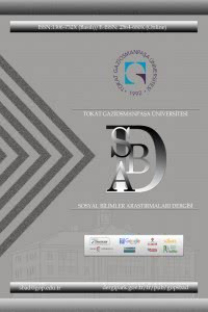Türkiye’de Doğrudan Yabancı Sermaye Yatırımlarının Bölgesel Belirleyicileri Üzerine Bir Eş Bütünleşme Analizi (1992–2003)
Son yirmi beş yıldır dünya ekonomisini artan bir ivme ile şekillendiren küresel rekabet ve küresel entegrasyon süreci pek çok ülkenin ekonomik kalkınma politikaları konusundaki paradigmalarında değişime yol açmıştır. Bunların başlıcaları, serbest piyasa ekonomisi serbest dış ticaret ve serbest sermaye hareketleridir. Dolayısıyla bu gelişim sürecinde üzerinde en fazla odaklanılan konu doğrudan yabancı sermaye yatırımları konusu olmuştur. Bu nedenle günümüzün küreselleşen dünyasında gerek sanayileşmiş gerekse sanayileşmekte olan ülkeler doğrudan yabancı sermayeyi kendilerine çekebilmek için büyük çaba harcamaktadırlar. Bunun sebebi, gittiği ülkelerin makro ekonomik göstergeleri üzerinde oluşturacağı olumlu etkilerdir. Ancak, doğrudan yabancı sermaye yatırımlarının belirleyicileri nelerdir? Çalışma, bu soruya Türkiye açısından açıklık getirmek için 1992-2003 dönemi baz alınarak doğrudan yabancı sermaye yatırımlarının bölgesel belirleyicilerinin (Location determinant) neler olduğunu belirlemeye yönelik VAR Modeli ve Eşbütünleşme Analiziyle (Cointegration) bu durumu ortaya koymayı amaçlamaktadır. Bu çalışmadan elde edilen sonuçlar yabancı yatırımlar ile Gayrisafi Yurtiçi Hasıla, Altyapı yatırımları ve Açıklık değişkenleri arasında pozitif faiz oranları, döviz kuru ve ücretler arasında ise negatif bir ilişkinin varlığını ortaya koymaktadır. Bu sonuçlar Türkiye’nin piyasa büyüklüğü, altyapı ve ekonominin açıklık oranı gibi bölgesel avantajlara sahip olduğuna işaret etmektedir
Anahtar Kelimeler:
Doğrudan Yabancı Sermaye Yatırımları, VAR Modeli, Makro Ekonomik Göstergeler, Eşbütünleşme Analizi.
Within the last 25 years, accelaration in global competition and global integration have many countries to shift their economic development paradigms. These ara mainly-free market economy- free foreign trade and free capital movement. Therefore within this process foreign direct Investment (FDI) has become one of the most discussed subject area. For this reason, both developed economies and developing economies attempting to attract foreign direct investment to their countries. Since FDI have a positive influence over host economies macro economic indicators. Hovever the guestion is, what are the determinants of FDI ? This study aims to figure out location determination of FDI in Turkey, 1992:2003. In order to that, VAR Models and Co-Integration Analysis are conductud. The evidence from this study supports that there is positive relationship between foreign direct investment and market size, infrastructure, openness and there is negative relationship between foreign direct investment and interest rate, wage and exchange rate. These results say that Turkey has several location advangates such that market size, infrastructure and openness of the economy.
Keywords:
Foreign Direct Investment, VAR Models, Macro Economic Indicators, Co-İntegration Analysis.,
___
- ALFARO, L., CHANDA A., OZCAN S., SAYEK S.(2004), FDI and eEonomic Growth: The Role of Local Financial Markets, Journal of International Economics, 64,89-112.
- ALICI A.A., UCAL M.Ş.(2003), Foreign Direct Investment, Export and Output Growth of Turkey:Causality Analysis, European Trade Study Group Fifth Annual Conference, 1-17
- BANEREJEE A., DOLADO J.J., GALBRAITH J.W., HENDRY D.F.(1993), Cointegration, Error Correction and The Econometric Analysis of Non- stationary Data, New York, Oxford University Pres.
- BATMAZ,Nihat, TUNCA, Halil (2005). Doğrudan Yabancı Sermaye Yatırımları ve Türkiye (1923-2003). Beta Başım Yayım A.Ş, 1.Baskı, İstanbul.
- BAYRAK, Sebahat, AKDİŞ, Muhammet, SERİNKAN, Celalettin (2004), Selçuk Üniversitesi, Sosyal ve Ekonomik Araştırmalar Dergisi, sayı:7.
- BIERENS H.J.(1997), Cointegration Analysis, http://grizzly.la.psu.edu/~hbierens/COINT.PDF
- Deichmann J., Karidis S., Sayek S.(2003), Foreign Direct Investment in Turkey: Regional determinants, Applied Economics, 35, 1767-1778.
- DİE (2003), İstatistik Göstergeler 1923–2002, Ankara
- DPT (2002b), Sayılarla Türkiye Ekonomisi, Ankara
- ENDERS W.(1995), Applied Econometric Time Series, John Wiley and Sons, Inc
- ERDAL F., TATOĞLU E.(2002), Locational Determinants of Foreign Direct Investment in an Emerging Market Economy:Evidence from Turkey, Multinational Business Review, 10, 1-7
- HENDRY D.F., JUSELIUS K.(2001), Explaning Cointegration Analysis:Part-II, The Energy Journal, 22, 76-120.
- İNSEL A., SUNGUR N.(2000), Sermaye Akımlarının Temel Makro Ekonomik Göstergeler Üzerindeki Etkileri:Türkiye Örneği 1989-1999, ODTÜ IV.Uluslararası İktisat Kongresi, 1-29
- JOHANSEN S., HANSEN P.R.(1998), Workbook on Cointegration, New York, Oxford University Pres.
- JOHANSEN S.(1991), Estimation and Hypothesis Testing of Cointegration Vector in Gaussian Vector Autoregressive Models, Econometrica, 59, 1551-1580.
- JOHANSEN S., JUSELIUS K.(1990), Maximum Likelihood Estimation and Inference on Cointegration:With Applications to the Demand for Money, Oxford Bulletin of Economics and Statistics, 52, 169-120.
- KAR, Muhsin, KARA M.A.(2003), Türkiye’ye Yönelik Sermaye Hareketleri ve Krizler, Dış Ticaret Dergisi, Sayı:29, Ankara , 46-80.
- KARAGÖL E.(2002), The Causality Analysis of External Debt Service and GNP:The Case of Turkey, Central Bank Review, 2, 39-64
- KAZGAN, Gülten (2002), Küreselleşme ve Ulus-Devlet, Yeni Ekonomik Düzen, İstanbul Bilgi Üniversitesi Yayınları, 3.Baskı, İstanbul.
- LI X., LIU X.(2005), Foreign Direct Investment and Economic Growth:An Increasingly Endogenous Relationship, World Development, 33, 393-407
- PARISTO, A. (1995), Recent Trends in Employment in Transnational Corparations, Foreign Direct Investment, Trade and Employment, Paris OECD Pub.
- SOLIMAN M.(2003), Foreign Direct Investment and LDCs Export:Evidence from the MENA Region, 1-23.
- TATOĞLU E., GLAISTER K.W.(1998), Performance of International Joint Venture in Turkey:Perspectives of Western firms and Turkish firms, International Business Review, 7, 635-656.
- TATOĞLU E., GLAISTER K.W.(1998), An Analysis of Motives for Western FDI in Turkey, International Business Review, 7, 203-230.
- TATOĞLU E., GLAISTER K.W.(1998), Western MNCs’ FDI in Turkey:An Analysis of Locational Specific Factors, Management International Review, 38, 133-159.
- UNCTAD (2000), World Investment Report
- UNCTAD (2001), World Investment Report
- UNCTAD (2002), World Investment Report
- UNCTAD (2003), World Investment Report
- UNCTAD, Foreign Direct Investment Performence and Potential Index, (www.unctad.org) (2004)
- YASED, Dünya da Yabancı Sermaye Yatırımları Raporu. http://www.worldbank.org
- http://www.imf.org
- http://www.dtm.gov.tr
- http://www.unctad.org
- http://www.die.gov.tr
- http://www.hazine.gov.tr
- http://stat.unctad.org/fdi/eng
- http://devdata.worldbank.org/dataonline/
- http://ekutup.dpt.gov.tr
- http://tcmbf40.tcmb.gov.tr/cbt.html
- ISSN: 1306-732X
- Yayın Aralığı: Yılda 2 Sayı
- Başlangıç: 2006
- Yayıncı: Gaziosmanpaşa Üniversitesi Sosyal Bilimler Enstitüsü
Sayıdaki Diğer Makaleler
Şerif KORKMAZ, Çavuş ŞAHİN, Aynur AYTAR
Gerçek Bir İkilem: Ödev Vermek Ya da Vermemek?
Sınıf İçi Gözlem Araç ve Teknikleri: Kavramsal Bir Çözümleme
Ebru OĞUZ ÇUHADAROĞLU, Kürşad YILMAZ
Eğitimde Araştırma Yöntemleri: İngilizce Öğretmenliği Hizmet Öncesi Eğitim Üzerine Bir Çalışma
Türkçe Ders Kitaplarında Yer Alan Edebi Metinlerin Öğrencilere Estetik Zevk Kazandırmadaki Rolü
Adem İŞCAN, Süleyman EFENDİOĞLU, Şükrü ADA
Öğretmen Adaylarının Değişkenlerin Kullanımı ile İlgili Bilgileri
Demokratik ve Şeffaf Yönetimi Anlamlandıran Bir Hak: ‘Bilgi Edinme Hakkı’
